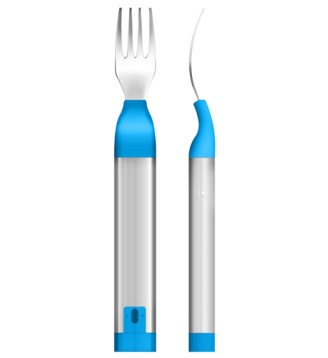 Chewdaism is the theory that chewing food slowly and thoroughly delivers health benefits.
Chewdaism is the theory that chewing food slowly and thoroughly delivers health benefits.
I first encountered this idea while reading AJ Jacobs’ Drop Dead Healthy: One Man’s Humble Quest for Bodily Perfection. It’s one of the healthy ideas he tries out during his year long experiment with improved exercise and nutrition habits.
Chewdaism is obviously a portmanteau (a combination of two words and their meanings) of the words “chew” and “Judaism” though there isn’t any connection that I can see between the idea and Jewish dietary laws.
According to Jacobs, Chewdaism is a kind of food mindfulness. The central tenet of Chewdaism, is that chewing your food 100 times before swallowing it makes you healthier. Jacobs aimed for just 50 chews and found even that a challenge. He describes a night where his family abandoned him at the table, and left him chewing away into the wee hours.
“They say chewing will cure stomachaches, improve energy, clear the mind, cut down on gas, and strengthen the bones,” Jacobs writes. “Those claims are overblown. But chewing does offer two advantages: You can wring more nutrition out of your food. And more important, chewing makes you thinner, as it forces you to eat more slowly.”
Eating slowly and paying attention to your food, mindful eating as they say, seems obviously to be a good idea. But how to tell if you’re eating slowly enough? Don’t worry. There’s now a fork that monitors your eating speed.
Food tracking which Tracy and I have both blogged about here may turn out to be small potatoes as far the Panopticon goes, given the new food health and nutrition apps and gadgets that are on the way. You can log your steps with a pedometer, of course but new versions of Google on your android phone estimate how far you’ve walked and biked based on the movement of your phone.
“Google Now continues to try and improve our daily lives one little step at a time, and the latest addition seems to be doing just that. Some users are reporting this card now appearing when they open up Google Now, which reports on the distances you walked and cycled in the last couple of months, with a comparison of the two. Pretty nifty, and while not quite at the same level as an actual pedometer, those of you who like to keep active will no doubt find it useful. How accurate it actually is — especially for the cycling — remains to be seen. Presumably this relies on having your location data, so turning this off should disable it if you’re not too keen.” Read more here, Google slips a walking and cycling tracking card into Google Now.
But back to the smart fork, pictured below. The vibrating fork doesn’t count your chews exactly but it does vibrate if you eat too quickly. Luckily, I don’t eat M and Ms or ice cream with a fork. From the article HapiFork Vibrates if You Eat Too Fast:
“The fork is, well, a fork. But inside it has a capacitive sensor that knows how long it has been since you have taken your last bite. Say you take a bite of that piece of fish, chew it and then go for another bite within 10 seconds. The fork will know that and gently vibrate to tell you have been eating too fast.
The fork also pairs with HapiLab’s iPhone app so you can see how long your meals are, how long you are pausing between bites and even track the number of times you bring the fork to your mouth. The app will also let you track your food intake”
I find myself thinking they could just have it give you mild electric shocks too while they’re at it. Slow mindful eating is good but this seems a bit much monitoring even by my standards. And I like good tracking!
Converting to Chew-daism on the Hip Chicks Blog
Vibrating “smart fork” for weight loss launches at CES at de zeen magazine

I think the “chewdaism”/Judaism thing isn’t so much about Jewish dietary laws as the fact that AJ Jacobs is Jewish. That’s probably all it is. It’s an interesting thing to try. I might try it myself, if it’s cheap. I wouldn’t spend a lot of money on it!
That’s what I thought too but Jacobs actually got the term from web surfing and found it on the Hippie Chicks macrobiotic site…so no idea where it comes from really.
A vibrating fork?…..oh, please! -how about just using a normal fork to eat more vegetables.
Yeah, that’s about how I feel. 🙂
This makes me laugh, because if I have a problem with eating speed, it is eating too slowly. (I am notorious among friends and family for being the last one to finish at meals.) I can’t say there’s any real benefit to it, and a certain amount of social discomfort that goes along with being a slower eater.